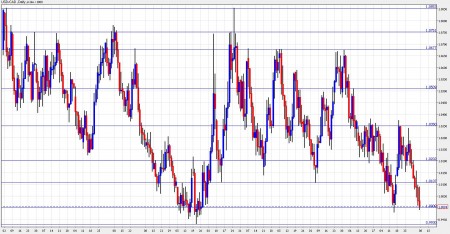Hosing data and Trade Balance are the major events for loonie traders this week. Here is an outlook on the market movers awaiting us.
USD/CAD daily chart with support and resistance lines marked. Click to enlarge:
Canada’s dollar dropped against most of its major counterparts after the government blocked a foreign takeover of Potash Corp. of Saskatchewan Inc., overpowering optimism related to rising stocks and raw materials. The loonie declined 0.2 percent to C$1.4240 versus the euro, from C$1.4213 in Nov 3. It tumbled 1.8 percent to 79.64 cents against the New Zealand dollar. It has climbed in six straight sessions versus the greenback in the longest stretch of gains since March 17. Will this week’s events further devalue the loonie?
- Housing Data: Monday, 14:15, 14:30. Homebuilding activity in Canada eased for a 6th consecutive month in September totaled 186,000 units 1.5% less than in the previous month but stronger than market expectations of 180K. Housing starts are now 9.4% off their peak in April of 2010. Homebuilding has been stronger than anticipated over the third quarter of this year, but largely driven by the volatile multiple unit components. Nonetheless, the modest downtrend in housing underway indicates that the housing market will correct itself in a gradual manner. A small drop to 181K is expected now while New Housing Price Index released on Tuesday, 14:30 measures changes over time in the contractors’ selling prices of new residential houses increased 0.1% in August following a 0.1% decrease in July. A higher rise of 0.5% is expected now Bullish for the CAD.
- Trade Balance: Wednesday, 14:30. Canada Trade Balance deficit narrowed to $1.3B, against expectations of -2.2B. The main sectors behind the decline in imports were automotive products, industrial goods and materials. These declines were tempered by increases in imports of other consumer goods and energy products. A small increase in deficit is predicted reaching $1.4B. While it is positive to see a narrowing trade balance, these numbers are still well off their pre-crisis levels of $4-$5B.
- G20 Meetings: Thursday-Friday. The fifth G20 Summit will take place on November 11 and 12, 2010 in Seoul, South Korea. The leaders of the 20 top world economies will follow up on previous commitments, including safeguarding the recovery, ensuring strong and sustainable global growth, building a stronger international financial regulatory system, and modernizing world financial institutions. In its last meeting the G-20 failed to end currency wars. Despite a massive effort by the U.S. and some of its allies, the only thing the ministers could agree to was a vague, toothless promise to try to avoid currency wars. This meeting is dedicated to agree a plan to avoid another global financial crisis.
* All times are GMT.
USD/CAD Technical Analysis
USD/CAD has been falling gradually throughout most of the week. A jump above 1.01 (mentioned last week) was temporary, and USD/CAD parity was reached at the end of the week, with the close just above this level – 1.0004.
Immediate resistance appears at 1.01 which provided support back in August. The next line of support is at 1.02, which was the low point in 2009 and now provides minor support.
Higher, the 1.0380 line is a very strong resistance line on the upside. It capped the pair several times in recent months, and was left untouched in the past weeks. Above, 1.05 held the pair twice during August and is a tough line.. Even higher, the stubborn 1.0680 served as resistance in July and in August, for more than one day in each attempt to break higher.
The next levels are far – 1.0750 was a swing high during May and also the limit of a long-term range in 2009. Even higher on the upside, 1.0850, which was also a swing high in May.
Looking down below the obvious line of parity, the year-to-date low of 0.9930 is the next support line, followed by 0.98 and 0.97, which were support lines back in 2008.
I am bearish USD/CAD.
After employment figures were OK, the QE2 program in the US is likely to push commodities higher – a higher price of oil means a stronger Canadian dollar.
Further reading:
- For a broad view of all the week’s major events worldwide, read the USD outlook.
- For EUR/USD, check out the Euro/Dollar forecast.
- For the Japanese yen, read the USD/JPY forecast.
- For GBP/USD (cable), look into the British Pound forecast.
- For the Australian dollar (Aussie), check out the AUD to USD forecast.
- For the New Zealand dollar (kiwi), read the NZD forecast.
- For USD/CAD (loonie), check out the Canadian dollar.
Want to see what other traders are doing in real accounts? Check out Currensee. It’s free..
